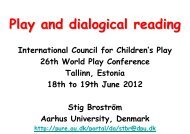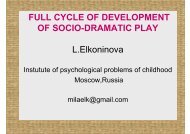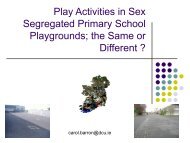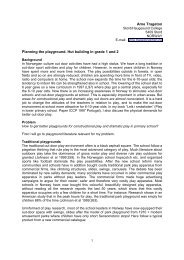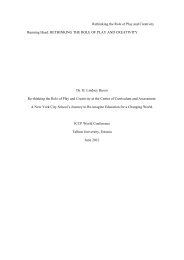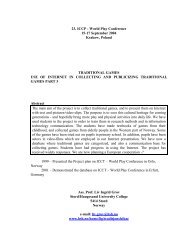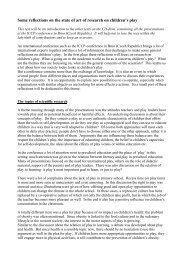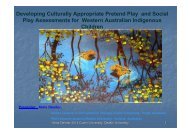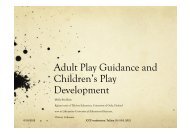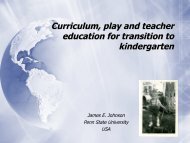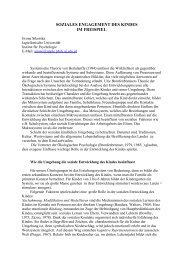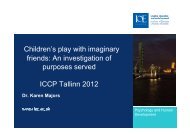1 Play in retro- and perspective Rimmert van der ... - Iccp-play.org
1 Play in retro- and perspective Rimmert van der ... - Iccp-play.org
1 Play in retro- and perspective Rimmert van der ... - Iccp-play.org
You also want an ePaper? Increase the reach of your titles
YUMPU automatically turns print PDFs into web optimized ePapers that Google loves.
<strong>Play</strong> <strong>in</strong> <strong>retro</strong>- <strong>and</strong> <strong>perspective</strong><br />
<strong>Rimmert</strong> <strong>van</strong> <strong>der</strong> Kooij<br />
1. Introduction<br />
Dur<strong>in</strong>g more than 40 years I had the opportunity to follow the development of <strong>play</strong> with<strong>in</strong> the<br />
European context. It is my <strong>in</strong>tention <strong>in</strong> the first place to look back to what happened <strong>in</strong> the past<br />
century. Which were the most important theories? Which <strong>play</strong> types were dist<strong>in</strong>guished? How<br />
do children <strong>play</strong> at different ages? What is the relation between <strong>play</strong> <strong>and</strong> therapy <strong>and</strong> last but not<br />
least between <strong>play</strong> <strong>and</strong> education?<br />
In the second part of my presentation I will try to look forward <strong>and</strong> shortly discuss the need for<br />
new theories about <strong>play</strong>. Further the issue of use <strong>and</strong> misuse of <strong>play</strong> seems an <strong>in</strong>evitable<br />
discussion po<strong>in</strong>t just like the theme of nature <strong>and</strong> nurture. F<strong>in</strong>ally one should consi<strong>der</strong> the<br />
relation between <strong>play</strong> <strong>and</strong> the <strong>in</strong>creas<strong>in</strong>g <strong>in</strong>fluence of technology.<br />
I start with tak<strong>in</strong>g a <strong>retro</strong>spective view of the past century, a historical orientation.<br />
In the <strong>in</strong>terest of future <strong>play</strong> research I mention a number of bibliographies, which can be helpful<br />
for ducumentation:<br />
1.1967 "Children's <strong>Play</strong> a research bibliography" (authors: R.E. Herron, S. Ha<strong>in</strong>es, G. Olsen & J.<br />
Hughes). Champaign (Ill<strong>in</strong>ois): Motor Performance Laboratory, Children's Research<br />
Center, University of Ill<strong>in</strong>ois.<br />
2.1971 "Dokumentation. Bibliography <strong>Play</strong> <strong>in</strong> Childhood". München: Deutsches Jugend<strong>in</strong>stitut.<br />
3.1976-1983 "Annual report of the leisure behavior reseach laboratory.” Champaign: University<br />
of Ill<strong>in</strong>ois.<br />
4.1976 "Thema Spielplatz. E<strong>in</strong>e kommentierte Bibliographie" (authors von Hase & Möller).<br />
München: Juventa Verlag.<br />
5.1978 & 1980 "Selective bibliography Preschool Education. Prague: Central Library.<br />
Pedagogical Faculty of the Charles University. (Five books with summaries of the described<br />
contributions).<br />
6.1980 "DJI Dokumentation. K<strong>in</strong><strong>der</strong>spiel und Spiel mit K<strong>in</strong><strong>der</strong>n" (author: B. Schrö<strong>der</strong>).<br />
München: Deutsches Jugend<strong>in</strong>stitut.<br />
7.1987 "Bibliography on <strong>play</strong> <strong>and</strong> <strong>play</strong> environments" (author: J. <strong>van</strong> Andel). Tilburg: IFIC-IPA.<br />
8.1997, 2000 "<strong>Play</strong> references" (author: J. Christie). Tempee: Arizona State University.<br />
Look<strong>in</strong>g back at the importance of <strong>play</strong> <strong>in</strong> the last century, I conclude that the general op<strong>in</strong>ion<br />
was that <strong>play</strong> <strong>play</strong>ed an important role <strong>in</strong> praxis <strong>and</strong> theory dur<strong>in</strong>g the first ten years of children's<br />
development. The great number of publications confirms this statement.<br />
1
2. <strong>Play</strong> <strong>in</strong> <strong>retro</strong>spective.<br />
As mentioned <strong>in</strong> the <strong>in</strong>troduction I will start with a short reconstruction of the history of <strong>play</strong><br />
theories.<br />
2.1. Theoretical approaches of <strong>play</strong> <strong>in</strong> the past<br />
One cannot deny that the structure <strong>and</strong> complexity of our society <strong>in</strong>fluenced the view upon <strong>play</strong>.<br />
In reality <strong>play</strong> became a topic of discussion dur<strong>in</strong>g the last part of the 18th century. Schiller's<br />
(1794) fundamental statement: "The human be<strong>in</strong>g is only complete, when he <strong>play</strong>s" is one of<br />
most frequent used citations from that period.<br />
A number of theories about <strong>play</strong> were formulated <strong>in</strong> the 19th century. Spencer (1855), Lazarus<br />
(1883), Hall (1904) <strong>and</strong> Groos (1901, 1922) belong to the first theorists of <strong>play</strong>. Their vision<br />
was dom<strong>in</strong>antly founded <strong>in</strong> Darw<strong>in</strong>'s evolutional theory of mank<strong>in</strong>d.<br />
Overview<strong>in</strong>g these different theoretical approaches they all expla<strong>in</strong> some typical aspects of the<br />
<strong>play</strong> behaviour. None, however, pays attention to the <strong>in</strong>dividual developmental aspect of<br />
children's <strong>play</strong>.<br />
In the 20th century a more <strong>in</strong>dividual approach was developed. However, new problems were<br />
created. The first problem which scientists <strong>and</strong> practitioners had to envisage was the manifold of<br />
theories. One general theory was lack<strong>in</strong>g, the developed theories expla<strong>in</strong>ed only one or two of<br />
the four follow<strong>in</strong>g behavioural patterns:<br />
-sensori-motor activities<br />
-cognitive behaviour<br />
-emotional reactions<br />
-social activities.<br />
Later, I will mention a number of the most applied theories.<br />
On top of the problem of the great number of theories, a k<strong>in</strong>d of scientific war with<strong>in</strong> the social<br />
sciences seemed to exist between advocates of the nomothetical, quantitative approaches, <strong>and</strong><br />
the hermeneutic, qualitative methods. Also <strong>in</strong> the world of the <strong>play</strong> researchers, one can discover<br />
this antithesis. In my op<strong>in</strong>ion the lack of <strong>in</strong>tegration of these types of approaches forms the<br />
second problem.<br />
To summarize: <strong>in</strong> my op<strong>in</strong>ion the ma<strong>in</strong> problems <strong>in</strong> the 20th century were<br />
1. the lack of one general theory<br />
2. the antithesis between the qualitative <strong>and</strong> the quantitative approaches.<br />
In or<strong>der</strong> to support my statements I will now mention some of the most applied <strong>play</strong> theories.<br />
2
Jean Château<br />
One of the most outspoken hermeneutic approaches came from the Frenchman Jean Château<br />
(1946, 1954). A number of his statements is <strong>in</strong>ternationally known. He formulated: "The<br />
challenge of the el<strong>der</strong> is the essential motor of childhood." And: "In the rules of <strong>play</strong> the child<br />
seeks a k<strong>in</strong>d of self-affirmation." This last statement ended <strong>in</strong> his ma<strong>in</strong> classification of <strong>play</strong> with<br />
<strong>and</strong> without rules. The ma<strong>in</strong> bor<strong>der</strong> between <strong>play</strong> without <strong>and</strong> with rules he located at the age of<br />
seven years. With<strong>in</strong> these periods he divided different <strong>play</strong> forms which are also mentioned by<br />
other theorist, which had a different theoretical background.<br />
Charlotte Bühler<br />
Charlotte Bühler (1928) is often characterized as the first mo<strong>der</strong>n theorist. She put an accent<br />
upon the importance of sensori-motor <strong>play</strong> for the child's development. Her theory concerned<br />
especially the concept of "function", with which she <strong>in</strong>tended the sensor-motor activities. Her<br />
statement: "It is not the concrete material which is be<strong>in</strong>g formed, but a movement, a function<br />
with <strong>and</strong> to the material is established" is still frequently cited. Her approach had a k<strong>in</strong>d of<br />
quantitative character by her systematic observation of a child.<br />
Piaget<br />
Piaget (1947, 1968, 1972) described the first two years <strong>in</strong> the child's development as 'the<br />
sensori-motor-phase'. In fact he dist<strong>in</strong>guished two <strong>play</strong> forms: sensori-motor-<strong>play</strong> <strong>and</strong> symbolic<br />
<strong>play</strong>. The last type starts to develop around the age of two years. Piaget's theoretical approach<br />
has its roots <strong>in</strong> biology. His fundamental idea of the equilibrium between assimilation <strong>and</strong><br />
accommodation shows this biological background. The dist<strong>in</strong>ction between <strong>play</strong> as a form of<br />
assimilation <strong>and</strong> imitation as a form of accomodation was one of the ma<strong>in</strong> reasons for the<br />
discussion between Piaget <strong>and</strong> Sutton-Smith <strong>in</strong> 1976. Sutton-Smith did not agree with the<br />
separation between <strong>play</strong> <strong>and</strong> imitation. Still, nobody can deny the importance of Piaget for the<br />
study of the child's development. His name is famous all over the world. However, his separation<br />
between <strong>play</strong> <strong>and</strong> imitation will <strong>in</strong> my op<strong>in</strong>ion start the discussion aga<strong>in</strong>, when <strong>in</strong> future new<br />
theoretical concepts will be developed. I will expla<strong>in</strong> that later <strong>in</strong> my suggestion for the<br />
development of new theories with<strong>in</strong> the <strong>perspective</strong> part of my presentation.<br />
Erikson<br />
Erikson (1974) was one of the few hermeneutic <strong>play</strong> theorists who looked <strong>in</strong>to the emotional<br />
aspects of <strong>play</strong>. His neo-psycho-analytical view was founded upon three pr<strong>in</strong>ciples: the so-called<br />
pleasure pr<strong>in</strong>ciple, the pr<strong>in</strong>ciple of repetition compulsion <strong>and</strong> the defence aga<strong>in</strong>st anxiety pr<strong>in</strong>ci<br />
3
ple. The orientation of the ego takes place <strong>in</strong> three circles: the auto-, the micro- <strong>and</strong> the macroatmosphere.<br />
In their theories Elkon<strong>in</strong> (1980) <strong>and</strong> Sutton-Smith (1978) un<strong>der</strong>l<strong>in</strong>e the social aspects of <strong>play</strong>.<br />
They emphasize the importance of the <strong>in</strong>itiatives of the educators for the <strong>play</strong> development. In<br />
fact the pr<strong>in</strong>ciple of modell<strong>in</strong>g was the basic start<strong>in</strong>g po<strong>in</strong>t of both theories. Interest<strong>in</strong>g was the<br />
accordance between these theoretical developments, which rooted <strong>in</strong> two totally different types<br />
of societies: communistic <strong>and</strong> capitalistic.<br />
2.3. The dist<strong>in</strong>ction of different <strong>play</strong> types<br />
For the praxis of early childhood education it seemed to be important to dist<strong>in</strong>guish different<br />
<strong>play</strong> forms. I doubt if <strong>in</strong> the future the categories will be applicable. Analyz<strong>in</strong>g the theories about<br />
<strong>play</strong>, it seemed logic to discover a common aspect <strong>in</strong> the different theoretical approaches.<br />
Already 30 years ago I came to the conclusion that almost every theorist dist<strong>in</strong>guished <strong>in</strong><br />
relation to <strong>in</strong>dividual <strong>play</strong> four <strong>play</strong> types:<br />
1. sensori-motor <strong>play</strong>, also known as function <strong>play</strong>. I prefer the descriptive name "repetition<br />
<strong>play</strong>", because the most dom<strong>in</strong>ant phenomenon of the sensorimotor <strong>play</strong> behaviour is the<br />
repetition of movements;<br />
2. imitation <strong>play</strong>, which is also known as symbolic <strong>play</strong> or fiction <strong>play</strong>;<br />
3. construction <strong>play</strong> <strong>in</strong> which mean<strong>in</strong>gless elements are put together to a sensible or mean<strong>in</strong>gful<br />
whole;<br />
4. world <strong>play</strong>, <strong>in</strong> which children build an own world with mean<strong>in</strong>gful elements (houses, trees<br />
men <strong>and</strong> animals). We preferred the concept 'group<strong>in</strong>g <strong>play</strong>', because of the group<strong>in</strong>g of toy<br />
elements.<br />
My preference for the use of descriptive terms of the different <strong>play</strong> types is the consequence of<br />
the fact, that one should avoid <strong>in</strong>clusive explanations from the passed <strong>and</strong> open the possibility<br />
for new theoretical explanations <strong>in</strong> the future.<br />
2.4. Relation between <strong>play</strong> behaviour <strong>and</strong> the developmental stage<br />
Mo<strong>der</strong>n theories about <strong>play</strong> often <strong>in</strong>dicate a relation between <strong>play</strong> form <strong>and</strong> age of the children<br />
(e.g. Bühler, Château, Erikson <strong>and</strong> Piaget). However, the experimental <strong>in</strong>vestigations about this<br />
subject are scarce. In fact, with<strong>in</strong> Europe only <strong>van</strong> Wylick (1936), <strong>van</strong> <strong>der</strong> Kooij (1977) <strong>and</strong> <strong>van</strong><br />
Gils (1992) were engaged <strong>in</strong> systematic <strong>play</strong> observations of children at different ages.<br />
That we live <strong>in</strong> a chang<strong>in</strong>g world becomes clear, when we compare the observation results of<br />
1936, 1977 <strong>and</strong> 1992. I will not bother you with tables <strong>and</strong> statistics. My conclusion is that<br />
between 1936 <strong>and</strong> 1992 repetition <strong>play</strong> (sensori-motor <strong>play</strong>) <strong>in</strong>creased <strong>and</strong> imitation <strong>play</strong><br />
4
dim<strong>in</strong>ished with percentages between 40 <strong>and</strong> 50%. The percentage of creative <strong>play</strong> types as<br />
construction <strong>and</strong> group<strong>in</strong>g <strong>play</strong> (world<strong>play</strong>) also reduced.<br />
One cannot avoid the challenge of explanation of these f<strong>in</strong>d<strong>in</strong>gs <strong>in</strong> the future.<br />
It is remarkable that general <strong>in</strong>ventories of the <strong>in</strong>dividual <strong>play</strong> at different ages as took place <strong>in</strong><br />
Europe, never happened <strong>in</strong> The United States of America.<br />
The American <strong>in</strong>terest for social <strong>play</strong> was more dom<strong>in</strong>ant. Already <strong>in</strong> 1933 Parten started her<br />
experimental <strong>and</strong> systematic observation of social <strong>play</strong>. Her observation categories (solitary,<br />
parallel, associative <strong>and</strong> cooperative <strong>play</strong>) built the basis for further research of social <strong>play</strong> as<br />
cont<strong>in</strong>ued by Barnes (1971), Rub<strong>in</strong> et al (1976) <strong>and</strong> Tizard et al (1976).<br />
2.5. The use of <strong>play</strong> <strong>in</strong> education <strong>and</strong> therapy<br />
With<strong>in</strong> the therapeutical divergence of approaches three ma<strong>in</strong> streams can de dist<strong>in</strong>guished:<br />
psychoanalytical, non-directive <strong>and</strong> behaviouristic approaches.<br />
Traditionally <strong>in</strong> therapeutical relations <strong>play</strong> is used as a form of communication. There are quite<br />
a few publications about the use of <strong>play</strong> with<strong>in</strong> the psycho-analytical approach. In fact Anna<br />
Freud (1972) <strong>and</strong> Kle<strong>in</strong> (1969) were the first scientists who described their experiences with<br />
<strong>play</strong> therapy sessions. More recently <strong>in</strong> Germany the work of Schäfer (1986, 1989) should be<br />
mentioned.<br />
The non-directive approach follow<strong>in</strong>g the pr<strong>in</strong>ciples of Rogers, was <strong>in</strong>troduced by Axl<strong>in</strong>e.<br />
With<strong>in</strong> the non-directive approaches <strong>play</strong> is treated as an orig<strong>in</strong>al activity of children <strong>and</strong> this<br />
aspect is often mentioned as legitimate base for its use. Schmidtchen (1991) was engaged <strong>in</strong> this<br />
therapeutic approach <strong>and</strong> recently <strong>in</strong> Germany Goetze (2002) presented a magnificent h<strong>and</strong>book<br />
with a survey of the non-directive approaches to children.<br />
Millar (1968) stated that <strong>in</strong> the Behaviouristic approach "often the <strong>play</strong> is reduced to noth<strong>in</strong>g." I<br />
agree with this statement, because the analytical method with<strong>in</strong> the learn<strong>in</strong>g psychology does not<br />
do the complexity of <strong>play</strong> actions <strong>and</strong> - activities justice. With a metaphor I compare <strong>play</strong> with a<br />
ball of yarn; when one unrolls the ball one must conclude, that the rema<strong>in</strong><strong>in</strong>g fibre is<br />
<strong>in</strong>compatible with the ball of yarn.<br />
Not only with<strong>in</strong> therapeutical approaches <strong>play</strong> is used or applied. Also <strong>in</strong> educational sett<strong>in</strong>gs<br />
<strong>play</strong> often forms a medium <strong>in</strong> or<strong>der</strong> to reach educational goals. <strong>Play</strong>ful created situations <strong>in</strong><br />
which didactic goals become attractive for children are becom<strong>in</strong>g popular. In Sc<strong>and</strong><strong>in</strong>avia<br />
Trageton (1997) had a great <strong>in</strong>fluence upon the relation between <strong>play</strong> <strong>and</strong> school. In Austria<br />
Hartmann (1988) is already almost three decades engaged <strong>in</strong> the topic of <strong>play</strong> <strong>and</strong> school <strong>and</strong> <strong>in</strong><br />
the United States Christie (1991) is s<strong>in</strong>ce many years active <strong>in</strong> this field.<br />
5
3. <strong>Play</strong> <strong>in</strong> <strong>perspective</strong><br />
I hope it becomes clear from my <strong>retro</strong>spective view that:<br />
- we need new theoretical approaches<br />
- the bor<strong>der</strong>s between nature <strong>and</strong> nurture should become clear <strong>in</strong> relation with educational <strong>and</strong><br />
therapeutic <strong>in</strong>terventions <strong>and</strong> also that<br />
- the topic of use <strong>and</strong> misuse of <strong>play</strong> requires further discussions <strong>and</strong> that<br />
- the consequence of technology should become a po<strong>in</strong>t of discussion.<br />
3.1. Need for new theoretical approaches<br />
We need new theoretical foundations for the explanation of human behaviour, especially <strong>in</strong><br />
relation to <strong>play</strong>. Unlike with other scientific discipl<strong>in</strong>es, we still work with theories which are<br />
over 30 years old. As human be<strong>in</strong>gs we are characterized by our cognitive capabilities. It seems<br />
to be logical that the view of mo<strong>der</strong>n approaches with<strong>in</strong> the cognitive psychology should be<br />
profited <strong>in</strong> the explanation of <strong>play</strong>, because they take <strong>in</strong>to account the <strong>in</strong>fluence of the activation<br />
of bra<strong>in</strong> cells. .<br />
The fundament of new approaches is the concept of "the production". The ma<strong>in</strong> characteristic of<br />
the production is the "if, then" property (compare <strong>van</strong> deer Kooij & Been, 1996):<br />
IF I eat an apple, THEN I eat fruit<br />
IF I eat fruit, THEN it is healthy<br />
IF I eat an apple, THEN it is healthy.<br />
In fact the result is: IF I eat an apple, THEN it is healthy. The second step "IF I eat fruit, THEN<br />
it is healthy" one can f<strong>org</strong>et <strong>and</strong> does no longer appeal to memorial storage.<br />
The fundamental thesis of mo<strong>der</strong>n cognitive approaches is that the comb<strong>in</strong>ation of a number of<br />
these 'if, then' steps results <strong>in</strong> efficient problem solv<strong>in</strong>g. This is not only the case <strong>in</strong> cognitive<br />
th<strong>in</strong>k<strong>in</strong>g processes, but also <strong>in</strong> sensori-motor problem solv<strong>in</strong>g dur<strong>in</strong>g <strong>play</strong>. An important sensorimotor<br />
learn<strong>in</strong>g process takes place when one learns to drive a car: IF I want to drive, THEN I<br />
must turn the key, IF I want to start the eng<strong>in</strong>e, THEN I must choose the gear, IF I want to<br />
drive, THEN I have to press the pedal. F<strong>in</strong>al result: IF I want to drive, THEN I have to press the<br />
pedal.<br />
The build-up of our functional systems, sensori-motor as well as cognitive, takes place along the<br />
chunk<strong>in</strong>g of these productions. The realisation of productions needs a lot of exercise, of repetition.<br />
In this way the huge amount of repetitions dur<strong>in</strong>g early <strong>play</strong> activities can be expla<strong>in</strong>ed.<br />
Learn<strong>in</strong>g curves dur<strong>in</strong>g early childhood are very steep. Thanks to <strong>play</strong>, <strong>and</strong> thanks to the<br />
<strong>in</strong>tensive repetition the development progresses.<br />
6
The metaphor <strong>in</strong> which I compared <strong>play</strong> with a ball of yarn, has not only the ad<strong>van</strong>tage of be<strong>in</strong>g<br />
a warn<strong>in</strong>g aga<strong>in</strong>st the use of analytical approaches. The second ad<strong>van</strong>tage is, that one can make<br />
clear, that almost every exist<strong>in</strong>g theoretical approach <strong>and</strong> most of the applied experimental designs<br />
show a one sided approach. If I would like to get a complete picture of the shown <strong>play</strong><br />
behaviour, you should approach it simultaneously from different <strong>perspective</strong>s. In the past I held<br />
a plea (<strong>van</strong> <strong>der</strong> Kooij, 1986) for the simultaneous application of observation categories <strong>and</strong> the<br />
use of the <strong>play</strong> <strong>in</strong>tensity scale, with concepts of <strong>in</strong>tr<strong>in</strong>sic motivation, <strong>in</strong>ternal locus of control <strong>and</strong><br />
suspension of reality. Two years ago dur<strong>in</strong>g the ICCP-conference I proposed the same type of<br />
approach for the observation <strong>and</strong> <strong>in</strong>terpretation of the social <strong>play</strong> behaviour.<br />
3.2. Use <strong>and</strong> misuse of <strong>play</strong><br />
Look<strong>in</strong>g back to the last century one cannot avoid the fundamental question <strong>in</strong> relation to<br />
education: Where are the divid<strong>in</strong>g l<strong>in</strong>es between use <strong>and</strong> misuse of <strong>play</strong>?<br />
As mentioned before <strong>play</strong> is often used as a medium <strong>in</strong> communication <strong>and</strong> education. Germany<br />
knows the tradition to speak of "Spielpädagogik" (= <strong>play</strong> education). Already some decades<br />
Heimlich (2001) pleads for '<strong>play</strong> education'. A four volume h<strong>and</strong>book of Kreuzer (1983) was<br />
named "H<strong>and</strong>book of <strong>play</strong> education".<br />
Ten years ago Sutton-Smith was <strong>in</strong>vited as '<strong>play</strong> pope' to the second Amsterdam <strong>Play</strong><br />
Symposium <strong>in</strong> or<strong>der</strong> to treat the fundamental problem: "Where are the bor<strong>der</strong>l<strong>in</strong>es between use<br />
<strong>and</strong> misuse of <strong>play</strong>?" He had a good presentation; however, this theme was only treated <strong>in</strong> the<br />
side-l<strong>in</strong>e. In the beg<strong>in</strong>n<strong>in</strong>g of this new century one cannot avoid, the unsolved problems of the<br />
20th century! Until now, this fundamental question of use <strong>and</strong> misuse has not been treated<br />
extensively enough. Freedom of <strong>play</strong>, one of its most fundamental characteristics, should not be<br />
threatened <strong>in</strong> educational or therapeutical situations. Therefore, guidel<strong>in</strong>es should be offered to<br />
educators <strong>and</strong> therapists.<br />
3.3. Divid<strong>in</strong>g l<strong>in</strong>es between education <strong>and</strong> <strong>in</strong>heritance<br />
Also <strong>in</strong> this new century we cannot deny the convergence theory as orig<strong>in</strong>ally formulated by<br />
Stern (later reconfirmed by Bronfenbrenner & Ceci (1994)) <strong>in</strong> which both nature <strong>and</strong> nurture<br />
<strong>play</strong> an important role <strong>in</strong> the child's development. In my op<strong>in</strong>ion the aspect of nature, of <strong>in</strong>born<br />
factors, upon the child behaviour has been neglected. This did not fit <strong>in</strong> the policy <strong>and</strong> philosophy<br />
of the 20th century, <strong>in</strong> which un<strong>der</strong> American <strong>in</strong>fluence, "everyth<strong>in</strong>g seemed to be make<br />
able". It is astonish<strong>in</strong>g that <strong>in</strong> the past century the discussion about nature <strong>and</strong> nurture was not<br />
more <strong>in</strong>fluential. This fact also has impact upon the former mentioned divid<strong>in</strong>g l<strong>in</strong>es between use<br />
<strong>and</strong> misuse of <strong>play</strong>, as educational <strong>in</strong>terventions are only justified when their goals are atta<strong>in</strong>able.<br />
7
3.4. The neglected <strong>in</strong>born factor of imitation<br />
Look<strong>in</strong>g back to the theories about the child development rather much attention is paid to the<br />
phenomenon of 'trial <strong>and</strong> error', which is already visible at an early stage <strong>in</strong> childhood. Because<br />
those behaviours are already observed among babies one can conclude that 'trial <strong>and</strong> error', often<br />
also related to curiosity, seems to be an <strong>in</strong>herited quality of mank<strong>in</strong>d.<br />
Observ<strong>in</strong>g the behaviour <strong>and</strong> especially the <strong>play</strong> behaviour of young children the amount of<br />
imitation of what happens <strong>in</strong> the surround<strong>in</strong>gs is remarkable. Piaget speaks about this behaviour<br />
as 'prereflexive imitation'. It is astonish<strong>in</strong>g that afterwards Piaget dist<strong>in</strong>guished <strong>play</strong> <strong>and</strong> imitation<br />
as separated dimensions. I agree with Sutton-Smith, that <strong>play</strong> <strong>and</strong> imitation cannot be separated.<br />
Imitation seems to be <strong>in</strong>born <strong>and</strong> <strong>in</strong> my op<strong>in</strong>ion is next to 'trial <strong>and</strong> error' the second <strong>in</strong>herited<br />
motor of especially the <strong>play</strong> behaviour. It deserves much more scientific attention <strong>and</strong> research<br />
<strong>in</strong> the future.<br />
3.5. Technology <strong>and</strong> <strong>play</strong><br />
From a theoretical po<strong>in</strong>t of view <strong>and</strong> from an experimental st<strong>and</strong>po<strong>in</strong>t I dare to state, that the<br />
environment of a child has an important <strong>in</strong>fluence upon the <strong>play</strong> behaviour.<br />
Also <strong>in</strong> the future the sensori-motor <strong>play</strong> of children un<strong>der</strong> four years of age will be of great<br />
importance for their further development as was the case <strong>in</strong> the passed centuries. The <strong>in</strong>fluence<br />
of the environment <strong>in</strong>creases rapidly after the age of four years.<br />
Study<strong>in</strong>g the changed environment <strong>in</strong> our <strong>in</strong>creas<strong>in</strong>gly technological world, can be raised the<br />
fundamental question which <strong>in</strong>fluence this will have upon the children's <strong>play</strong> behaviour.<br />
A lot of children already <strong>play</strong> computer games at the age of three or four. This causes the need<br />
for new observation strategies. The former mentioned observation-categories (repetition,<br />
imitation <strong>play</strong>, etc) which are applied <strong>in</strong> the last century, do not seem useful nowadays. A lot of<br />
actions which were visible <strong>in</strong> the traditional <strong>play</strong> forms, seem to become <strong>in</strong>visible for observers<br />
dur<strong>in</strong>g computer <strong>play</strong>. I dare to predict, that we need to develop new observation strategies <strong>in</strong><br />
or<strong>der</strong> to judge the <strong>play</strong> behaviour beh<strong>in</strong>d the computer. The traditional observation categories<br />
focussed upon the way children treated their surround<strong>in</strong>gs <strong>and</strong> their toys. In fact this concerns a<br />
form aspect, because the ma<strong>in</strong> criterion was the way children h<strong>and</strong>led the toys. Maybe, we need<br />
a more content oriented observation system <strong>in</strong> the future.<br />
In a chang<strong>in</strong>g Western world, we need new theories, new observation methods <strong>and</strong> last but not<br />
least more attention for children's <strong>play</strong> <strong>in</strong> our Western societies!<br />
Bibliography<br />
Barnes, K. (1971). Preschool <strong>Play</strong> Norms. Developmental Psychology,5,1; 99-103<br />
8
Bühler, Ch. (1928). K<strong>in</strong>dheit und Jugend. Leipzig: Hirzel Verlag.<br />
Château, J. (1946). Le jeu de l'enfant après trois ans, sa nature, sa discipl<strong>in</strong>e. Paris: Librairie<br />
Philosophique.<br />
Château, J. (1954). l'Enfant et le jeu. Paris: Ed. du Scarabée.<br />
Christie, J. (1991). <strong>Play</strong> <strong>and</strong> early literacy development. Albany: State University of New York<br />
Press.<br />
Elkon<strong>in</strong>, D. (1980). Psychologie des Spiels. Berl<strong>in</strong>: Volk und Wissen.<br />
Erikson, E.H. (1974). Childhood <strong>and</strong> Society. Harmondsworth: Pengu<strong>in</strong> Books.<br />
Freud, A. (1972). E<strong>in</strong>führung <strong>in</strong> die Technik <strong>der</strong> K<strong>in</strong><strong>der</strong>analyse. München: Re<strong>in</strong>hardt Verlag.<br />
Gils, J. <strong>van</strong> (1992) De tijdsvested<strong>in</strong>g, de tijdsbelev<strong>in</strong>g en de opvoed<strong>in</strong>g op woensdag. Leuven:<br />
Katholieke Universiteit, Dissertation.<br />
Goetze, H. (2002). H<strong>and</strong>buch <strong>der</strong> personenzentrierten Spieltherapie.Gött<strong>in</strong>gen: Hogrefe.<br />
Hall, G.S. (1904). Adolescence. New York: Appleton.<br />
Hartmann, W. (1988) Spiel und elementares Lernen. Wien: Österreichischer Bundesverlag.<br />
Groos, K. (1901). The <strong>play</strong> of man. New York: Appleton.<br />
Groos, K. (1922). Das Spiel. Jena: Gustav Fischer.<br />
Heimlich, U. (2001). E<strong>in</strong>führung <strong>in</strong> die Spielpädagogik. Bad Heilbrunn: Kl<strong>in</strong>khardt.<br />
Kle<strong>in</strong>, M. (1969). Die psychoanalytische Spieltechnik, ihre Geschichte und Bedeutung. In G.<br />
Biermann: H<strong>and</strong>buch <strong>der</strong> K<strong>in</strong><strong>der</strong>psychotherapie B<strong>and</strong> I. München: Re<strong>in</strong>hardt.<br />
Kooij, R. <strong>van</strong> <strong>der</strong> (1977). Toy <strong>and</strong> <strong>Play</strong> Study. In R. <strong>van</strong> <strong>der</strong> Kooij & R.de Groot: That's All <strong>in</strong><br />
the Game. Rhe<strong>in</strong>stetten: Sch<strong>in</strong>dele.<br />
Kooij, R. <strong>van</strong> <strong>der</strong> (1985). Multidimensionale Untersuchungen des Spielverhaltens. In W.<br />
E<strong>in</strong>siedler (Hrsg): Aspekte des K<strong>in</strong><strong>der</strong>spiels. We<strong>in</strong>heim: Beltz, p. 32-66.<br />
Kooij, R. <strong>van</strong> <strong>der</strong> (1986). Different approaches to <strong>play</strong> behavior. In R. <strong>van</strong> <strong>der</strong> Kooij & J.<br />
Hellendoorn: <strong>Play</strong>, <strong>Play</strong> Therapy <strong>and</strong> <strong>Play</strong> Research. Lisse: Swets & Zeitl<strong>in</strong>ger.<br />
Kooij, R. <strong>van</strong> <strong>der</strong> (1996). Neue Modelle für die diagnostische Praxis. Bern: Hubert.<br />
Kreuzer, K.J. (1983). H<strong>and</strong>buch <strong>der</strong> Spielpädagogik. B<strong>and</strong> 1-4. Düsseldorf: Schwann-Bagel.<br />
Lazarus, M. (1883). Die Reize des Spiels. Berl<strong>in</strong>: Dummler.<br />
Millar, S. (1968). The psychology of <strong>play</strong>. Harmondsworth: Pengu<strong>in</strong> Books.<br />
Parten, M.B. (1933). Social <strong>Play</strong> amongst Preschool Children. Journal of Abnormal Sociology<br />
<strong>and</strong> Psychiatry,nr 28, 136-146.<br />
Piaget, J. (1947). La représentation du monde chez l'enfant. Paris: Presses universitaires de<br />
France.<br />
Piaget, J. (1972). <strong>Play</strong>, Dreams <strong>and</strong> Imitation. London: Routledge <strong>and</strong> Kegan Paul.<br />
Piaget, J. (1968). La formation du symbole chez l'enfant. Neuchâtel: Delachaux et Niestlé.<br />
Rub<strong>in</strong>, K.H., Maioni, T. & Hornung, M. (1976). Free <strong>Play</strong> Behaviors <strong>in</strong> Middle- <strong>and</strong> Lower<br />
Class Preschoolers: Parten <strong>and</strong> Piaget Revisited. Child Development,53, 651-657.<br />
Schäfer, G. (1986). Spiel, Spielraum und Verständigung. We<strong>in</strong>heim: Juventa.<br />
Schäfer, G. (1989). Spielphantasie und Spielumwelt. We<strong>in</strong>heim: Juventa.<br />
Schmidtchen, S. (1991). Klientzentrierte Spiel- und Familientherapie. We<strong>in</strong>heim: Psychologie<br />
Verlags Union.<br />
Schiller, F. (1794). Über die ästhetische Erziehung des Menschens <strong>in</strong> e<strong>in</strong>er Reihe von Briefen.<br />
(B<strong>and</strong> 12). Stuttgart: Cotta.<br />
Spencer, H, (1855). The pr<strong>in</strong>ciples of psychology. London: Logman, Brown, Green &<br />
Longmans.<br />
Sutton-Smith, B. (1976). In A. Flitner (Hrsg): Das K<strong>in</strong><strong>der</strong>spiel. München: Piper; 115-125.<br />
9
Sutton-Smith, B. (1978). Die Dialektik des Spiels. Schorndorf: Hofmann.<br />
Tizard, B. Philps, J. & Plewis, I. (1976). <strong>Play</strong> <strong>in</strong> preschool-I. <strong>Play</strong> measures <strong>and</strong> their relation to<br />
age, sex <strong>and</strong> I.Q. Journal of Child Psychology <strong>and</strong> Psychiatry,17, 251-264<br />
Trageton, A. (1997) Leik i småskolen (<strong>play</strong> <strong>in</strong> lower primary school). Bergen: Fagbogforlaget.<br />
Wylick, M. <strong>van</strong> (1936). Die Welt des K<strong>in</strong>des <strong>in</strong> se<strong>in</strong>er Darstellung. Wien: Josef Eberle.<br />
10



